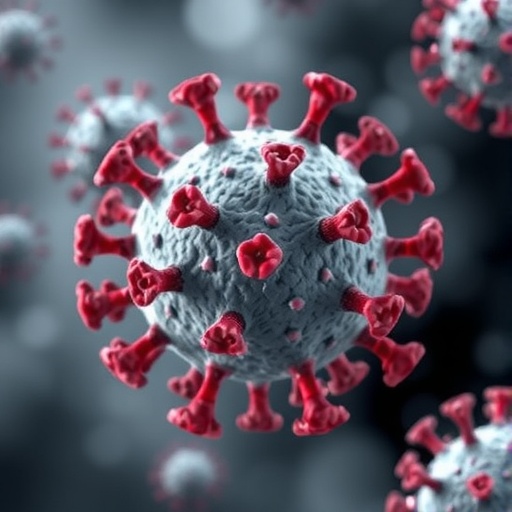In a groundbreaking study that promises to reshape our understanding of bacterial persistence, researchers from Umeå University have uncovered the vital role of the protein RfaH in enabling bacteria to survive and thrive within the hostile environment of the human body. This discovery not only advances basic microbiological knowledge but also paves the way for innovative antimicrobial therapies aimed at combating stubborn infections that resist conventional treatments.
The human body presents an immense challenge for invading bacteria, subjecting them to relentless assaults that include immune attacks, nutrient deprivation, and exposure to harmful compounds such as bile salts and acidic conditions. Against these odds, certain bacterial species manage to establish long-lasting infections, evading immune responses and surviving antibiotic treatments. At the heart of this resilience lies a finely tuned molecular machinery, of which RfaH has now been identified as a critical component.
Kemal Avican, leading the research team at the Department of Molecular Biology and IceLab at Umeå University, describes RfaH as a molecular guardian that ensures the successful transcription of genes essential for bacterial survival. Transcription is the fundamental process by which the genetic code in DNA is converted into messenger RNA, directing the synthesis of proteins. RfaH specifically prevents premature termination during transcription, acting as an “anti-terminator” that guarantees the complete expression of key operons—long stretches of genes that bacteria rely on for adaptive functions.
By focusing on Yersinia pseudotuberculosis, a well-established model organism for studying gut infections, the team demonstrated that the absence of RfaH severely compromises the bacterium’s ability to sustain infection. Experiments revealed that bacteria lacking RfaH were unable to mount effective defenses when nutrients were scarce and hostile environmental stressors were high, leading to a dramatic reduction in their persistence within host tissues.
The timing of RfaH activation is equally crucial. The protein’s production escalates during late bacterial growth phases and under stressful conditions, suggesting that it functions as part of an adaptive response mechanism. This temporal regulation allows bacteria to conserve energy under favorable conditions and rapidly switch to defense mode when survival is threatened, a strategy that enhances their overall fitness during infection.
In vivo mouse model experiments highlighted the protein’s impact on virulence. Nearly all mice subjected to infection with normal bacteria developed persistent infections, whereas only about 20% of the animals infected with RfaH-deficient strains showed signs of infection. This stark contrast translated into significantly improved survival outcomes for the animals, underscoring the protein’s indispensable role in pathogenesis.
At the molecular level, RfaH’s influence extends to the maintenance and production of surface structures pivotal for bacterial interaction with the host immune system. It regulates the biosynthesis of the O-antigen, an essential component of the bacterial outer membrane that serves as a protective barrier against immune detection and facilitates evasion tactics. Without a fully functional O-antigen layer, bacteria become vulnerable, leading to diminished virulence.
Moreover, RfaH orchestrates the expression of numerous downstream genes involved in processes such as attachment to host tissues, motility, and nutrient uptake. These multifaceted roles highlight the protein’s central position in coordinating a broad survival repertoire, enabling bacteria to adapt dynamically to evolving conditions within the host.
Importantly, RfaH is conserved across many bacterial species, including commensal members of the microbiota. Therefore, directly targeting RfaH for antimicrobial intervention may risk collateral damage to beneficial bacteria. However, the study proposes that focusing on the downstream gene networks it controls might offer selective avenues to neutralize pathogenic bacteria while preserving the integrity of the microbiota.
Joram Kiriga Waititu, first author of the study and postdoctoral fellow at Umeå University, emphasizes this precision approach: “Our findings open a new antimicrobial paradigm. By disrupting the specific genetic programs activated downstream of RfaH, it may be possible to disarm pathogens without harming the beneficial bacteria that are essential for human health.”
The broader implication of this research is profound given that while Yersinia pseudotuberculosis often causes self-limiting infections, it serves as a model for persistent and recurrent gut pathogens such as Escherichia coli, Salmonella, and Helicobacter species. Insights gleaned here could therefore translate into novel therapeutic strategies designed to overcome antibiotic resistance and chronic infection challenges inherent to these clinically significant bacteria.
Published in the journal mBio, this study received funding from the Swedish Research Council, Umeå Centre for Microbial Research (UCMR), the Stress Response Modeling at IceLab Centre of Research Excellence, Kempestiftelserna, and the Medical Faculty at Umeå University. The research represents a significant stride toward a future where persistent bacterial infections can be effectively managed by targeting their molecular survival tactics rather than solely relying on traditional antibiotics.
As bacterial infections continue to evade current treatments and threaten global health, understanding and dismantling the molecular defenses bacteria employ becomes imperative. The identification of RfaH’s pivotal role provides a promising target for drug development, heralding a new era in the fight against infectious diseases that have long resisted eradication.
Subject of Research: Animals
Article Title: RfaH is essential for virulence and adaptive responses in Yersinia pseudotuberculosis infection
News Publication Date: 29-Sep-2025
Web References: DOI link
Image Credits: Hans Karlsson / Umeå University
Keywords: Microbiology, Infectious diseases, Molecular biology, Bacterial genetics, RNA sequencing
Tags: antibiotic resistance challengesantimicrobial therapy innovationsbacterial persistence mechanismscombating stubborn bacterial infectionsgene expression in pathogensimmune evasion strategies in bacterialong-lasting bacterial infectionsmicrobiological breakthroughsmolecular bodyguard protein RfaHsurvival of bacteria in human bodytranscription regulation in bacteriaUmeå University research study





